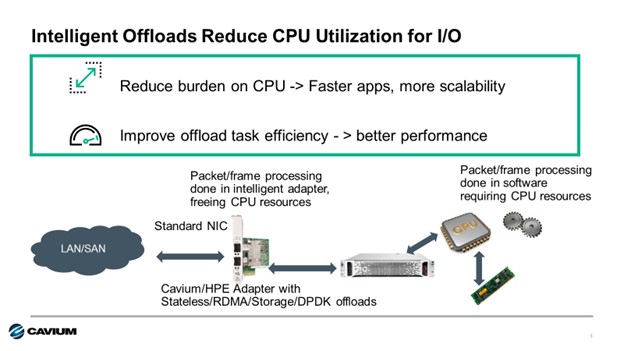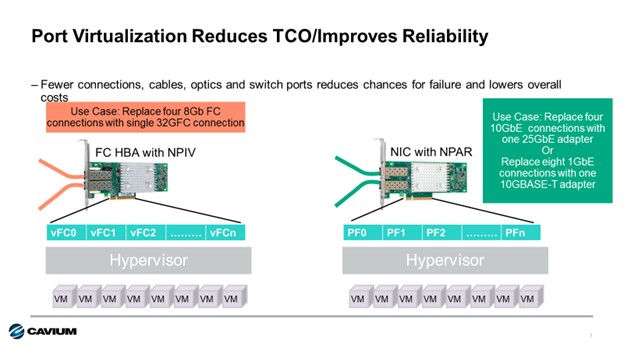

By Maen Suleiman, Senior Software Product Line Manager, Marvel
As more workloads are moving to the edge of the network, Marvell continues to advance technology that will enable the communication industry to benefit from the huge potential that network function virtualization (NFV) holds. At this year’s Mobile World Congress (Barcelona, 26th Feb to 1st Mar 2018), Marvell, along with some of its key technology collaborators, will be demonstrating a universal CPE (uCPE) solution that will enable telecom operators, service providers and enterprises to deploy needed virtual network functions (VNFs) to support their customers’ demands.
The ARMADA® 8040 uCPE solution, one of several ARMADA edge computing solutions to be introduced to the market, will be located at the Arm booth (Hall 6, Stand 6E30) and will run Telco Systems NFVTime uCPE operating system (OS) with two deployed off-the-shelf VNFs provided by 6WIND and Trend Micro, respectively, that enable virtual routing and security functionalities. The CyberTAN white box solution is designed to bring significant improvements in both cost effectiveness and system power efficiency compared to traditional offerings while also maintaining the highest degrees of security.
CyberTAN white box solution incorporating Marvell ARMADA 8040 SoC The CyberTAN white box platform is comprised of several key Marvell technologies that bring an integrated solution designed to enable significant hardware cost savings. The platform incorporates the power-efficient Marvell® ARMADA 8040 system-on-chip (SoC) based on the Arm Cortex®-A72 quad-core processor, with up to 2GHz CPU clock speed, and Marvell E6390x Link Street® Ethernet switch on-board. The Marvell Ethernet switch supports 10G uplink and 8 x 1GbE ports along with integrated PHYs, four of which are auto-media GbE ports (combo ports).
The CyberTAN white box benefits from the Marvell ARMADA 8040 processor’s rich feature set and robust software ecosystem, including:
In addition, the uCPE platform supports Mini PCI Express (mPCIe) expansion slots that can enable Marvell advanced 11ac/11ax Wi-Fi or additional wired/wireless connectivity, up to 16GB DDR4 DIMM, 2 x M.2 SATA, one SATA and eMMC options for storage, SD and USB expansion slots for additional storage or other wired/wireless connectivity such as LTE.
At the Arm booth, Telco Systems will demonstrate its NFVTime uCPE operating system on the CyberTAN white box, with zero-touch provisioning (ZTP) feature. NFVTime is an intuitive NFVi-OS that facilitates the entire process of deploying VNFs onto the uCPE, and avoids the complex and frustrating management and orchestration activities normally associated with putting NFV-based services into action. The demonstration will include two main VNFs:
Please contact your Marvell sales representative to arrange a meeting at Mobile World Congress or drop by the Arm booth (Hall 6, Stand 6E30) during the conference to see the uCPE solution in action.
By Todd Owens, Field Marketing Director, Marvell
Like a kid in a candy store, choose I/O wisely.
Remember as a child, a quick stop to the convenience store, standing in front of the candy aisle your parents saying, “hurry and pick one.” But with so many choices, the decision was often confusing. With time running out, you’d usually just grab the name-brand candy you were familiar with. But what were you missing out on? Perhaps now you realize there were more delicious or healthy offerings you could have chosen.
I use this as an analogy to discuss the choice of I/O technology for use in server configurations. There are lots of choices and it takes time to understand all the differences. As a result, system architects in many cases just fall back to the legacy name-brand adapter they have become familiar with. Is this the best option for their client though? Not always. Here’s some reasons why.
Some of today’s Ethernet adapters provide added capabilities that I refer to as “Intelligent I/O”. These adapters utilize a variety of offload technology and other capabilities to take on tasks associated with I/O processing that are typically done in software by the CPU when using a basic “standard” Ethernet adapter. Intelligent offloads include things like SR-IOV, RDMA, iSCSI, FCoE or DPDK. Each of these offloads the work to the adapter and, in many cases, bypasses the O/S kernel, speeding up I/O transactions and increasing performance.
As servers become more powerful and get packed with more virtual machines, running more applications, CPU utilizations of 70-80% are now commonplace. By using adapters with intelligent offloads, CPU utilization for I/O transactions can be reduced significantly, giving server administrators more CPU headroom. This means more CPU resources for applications or to increase the VM density per server.
Another reason is to mitigate performance impact to the Spectre and Meltdown fixes required now for X86 server processors. The side channel vulnerability known as Spectre and Meltdown in X86 processors required kernel patches from the CPU vendor. These patches can have a significantly reduce CPU performance. For example, Red Hat reported the impact could be as much as a 19% performance degradation. That’s a big performance hit.
Storage offloads and offloads like SR-IOV, RDMA and DPDK all bypass the O/S kernel. Because they bypass the kernel, the performance impacts of the Spectre and Meltdown fixes are bypassed as well. This means I/O transactions with intelligent I/O adapters are not impacted by these fixes, and I/O performance is maximized.
Finally, intelligent I/O can play a role in reducing cost and complexity and optimizing performance in virtual server environments. Some intelligent I/O adapters have port virtualization capabilities. Cavium Fibre Channel HBAs implement N-port ID Virtualization, or NPIV, to allow a single Fibre Channel port appear as multiple virtual Fibre Channel adapters to the hypervisor. For Cavium FastLinQ Ethernet Adapters, Network Partitioning, or NPAR, is utilized to provide similar capability for Ethernet connections. Up to eight independent connections can be presented to the host O/S making a single dual-port adapter look like 16 NICs to the operating system. Each virtual connection can be set to specific bandwidth and priority settings, providing full quality of service per connection.
The advantage of this port virtualization capability is two-fold. First, the number of cables and connections to a server can be reduced. In the case of storage, four 8Gb Fibre Channel connections can be replaced by a single 32Gb Fibre Channel connection. For Ethernet, eight 1GbE connections can easily be replaced by a single 10GbE connection and two 10GbE connections can be replaced with a single 25GbE connection, with 20% additional bandwidth to spare.
At HPE, there are more than fifty 10Gb-100GbE Ethernet adapters to choose from across the HPE ProLiant, Apollo, BladeSystem and HPE Synergy server portfolios. That’s a lot of documentation to read and compare. Cavium is proud to be a supplier of eighteen of these Ethernet adapters, and we’ve created a handy quick reference guide to highlight which of these offloads and virtualization features are supported on which adapters. View the complete Cavium HPE Ethernet Adapter Quick Reference guide here.
For Fibre Channel HBAs, there are fewer choices (only nineteen), but we make a quick reference document available for our HBA offerings at HPE as well. You can view the Fibre Channel HBA Quick Reference here.
In summary, when configuring HPE servers, think twice before selecting your I/O device. Choose an Intelligent I/O Adapter like those from HPE and Cavium. Cavium provides the broadest portfolio of intelligent Ethernet and Fibre Channel adapters for HPE Gen9 and Gen10 Servers and they support most, if not all, of the features mentioned in this blog. The best news is that the HPE/Cavium adapters are offered at the same or lower price than other products with fewer features. That means with HPE and Cavium I/O, you get more for less, and it just works too!
By Maen Suleiman, Senior Software Product Line Manager, Marvell
Marvell’s ground-breaking ARMADA® 38x processor series continues to see momentum in integration into new network and security designs. Most recently, the ARMADA 385 processor has been incorporated into Netgate’s new SG-3100 product offering.
Netgate’s objective with the SG-3100 was to bring to market an entry-level secure gateway solution that offered substantially more horsepower than competing products in the same price range. The target criteria for the new design were:
Marvell’s engineering team was pleased to collaborate with Netgate on this ambitious project.
Figure 1: Netgate SG-3100 powered by Marvell ARMADA 385
Processor The SG-3100 exhibits a high degree of flexibility and can be employed as a security firewall, LAN, router or WAN router, or VPN solution. It can also act as a DHCP server or DNS server, as well as providing intrusion detection system (IDS) and intrusion prevention system (IPS) capabilities. This extremely configurable unit comes equipped with 8GB eMMC Flash data storage or two m.2 SATA-based solid-state drives (SSDs), and also supports the LTE standard. Thanks to its Marvell® 88E6141 4-port switched LAN interface, the compact, cost-effective product easily facilitates bridging multiple wired and wireless networks.
Several factors drove Netgate’s decision to use Marvell’s ARMADA 385, starting with the ARMADA 38x ecosystem, which includes the ARMADA 38x ClearFog community board from SolidRun, and the ARMADA 38x FreeBSD port developed by Semihalf. Additionally, an increasing number of pfSense users had requested access to a board that provided three Ethernet ports, especially for dual-WAN operation. The ARMADA 385’s extensive embedded connectivity satisfies this need.
Based on the Arm® Cortex®-A9 topology, the ARMADA 385 system-on-chip (SoC) at the heart of the SG-3100 provides highly effective, dual-core processing capabilities. The SoC has a total of three Ethernet ports - two that support 1 Gbps data rates and a third capable of supporting either 2.5 Gbps or 1 Gbps. In the SG-3100 design, the ARMADA 385 is accompanied by Marvell’s 88E6141 multi-port Ethernet switch, which also supports 2.5Gbps operation through one of its ports.
The Netgate SG-3100 runs at 1.6GHz and is ideal for small offices and domestic environments. And thanks to the constituent IC technology, this solution packs serious throughput at a very compelling price.